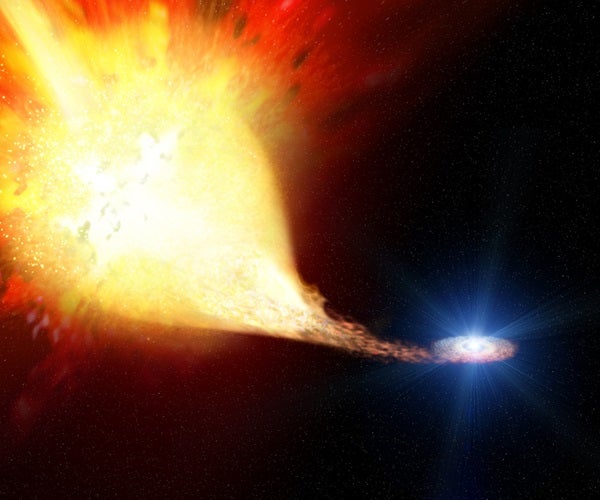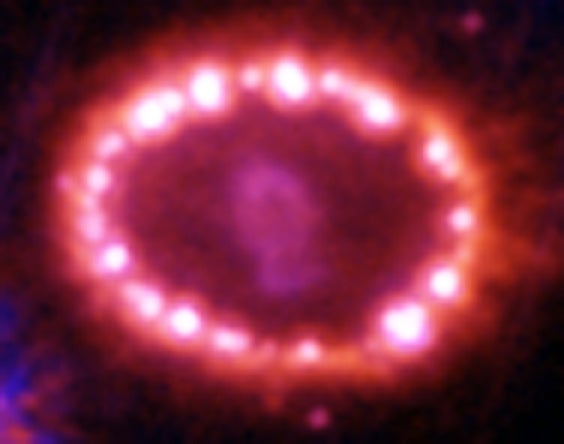Just as people do, stars have a finite life. Born in dusty gas clouds of a galaxy’s spiral arms, stars fuse hydrogen into heavier elements during their energy-producing lifetimes.
For stars, mass translates into destiny. The smallest can glow like embers for trillions of years. A middleweight star like our Sun burns steadily for 10 billion years; eventually, it puffs off its outer layers as expanding gaseous shells known as a planetary nebula. The most massive stars — furiously hot, blue-white orbs — shine brightly for a few million years and end their lives in spectacular explosions.

Bringing the universe to your door. We’re excited to announce Astronomy magazine’s new Space and Beyond subscription box – a quarterly adventure, curated with an astronomy-themed collection in every box. Learn More >>.
Supernova explosions are rare, but incredible. In a mere second, a supernova unleashes as much energy as the sum of all other stars in the observable universe. For weeks, the shattered star may rival the light output of its entire host galaxy.
The brightest recent supernova occurred in 1987 in the Large Magellanic Cloud, a satellite galaxy of the Milky Way 168,000 light-years away. The explosion, known as Supernova 1987A, left behind a remnant that’s changing as astronomers watch. A shock wave traveling at 10 million mph (16 million km/h) is plowing into a ring of gas ejected before the star died. This heats knots of gas in the ring to more than 18 million degrees F (10 million degrees C) — so hot the knots emit X rays.
Stars fuse hydrogen and helium into heavier elements such as oxygen, carbon, and iron, but the remaining elements are forged in the heart of supernova explosions. The blasts cast these heavy elements into the universe, enriching the galaxy for the next stellar generation. Atoms in our bodies, including the iron in our blood and the calcium in our teeth, were scattered into space during the deaths of massive stars. As Carl Sagan was fond of saying, we are made of star stuff.
Supernovae are not created equal, however. In cataloging these beasts, astronomers have found significant spectral differences. The current classification scheme, devised in 1941 by American astronomer Rudolph Minkowski of California’s Mt. Wilson Observatory, focuses on hydrogen, which is easy to trace. A type I supernova is one that shows no broad absorption lines or emission lines corresponding to hydrogen. If the supernova shows hydrogen either in absorption or emission, astronomers class the exploding star as type II.
Type I supernovae are remarkably consistent; it’s easy to recognize them throughout the universe. Later, some peculiarities arose. Astronomers found some type I supernovae lacking silicon, and they occasionally found others that showed the presence of helium. Scientists dubbed these rare, strange creatures types Ib and Ic supernovae and reclassified all others as type Ia.
By the 1990s, astronomers had amassed a wide enough set of observations to say with some confidence what kinds of stars are exploding.
Generally, a type Ia supernova is the result of a remnant white dwarf stealing material from a companion star. If the rate at which the stolen gas falls onto the dwarf is slow enough, the material accumulates on the dwarf’s surface rather than immediately fusing. The white dwarf slowly gains mass, and as it approaches a critical mass of around 1.4 times the mass of the Sun, it explodes with fury.
For years, scientists believed all type Ia explosions were produced when a white dwarf collects gas from a larger companion. But around 2004, researchers found evidence that suggests type Ia may be the result of this method as well as another — when two white dwarfs collide in explosive fashion.
On the other hand, Supernova 1987A was a type II supernova. It began its life as a brightly glowing blue-white star more than eight times the mass of the Sun. As a star this size exhausts its hydrogen fuel, it fuses ever-heavier elements, ultimately leaving a dense iron core surrounded by shells of silicon, oxygen, carbon, and helium.
But iron fusion requires more energy than it produces, and this causes the star’s iron core to collapse. At densities exceeding that of an atomic nucleus, the inner core stiffens, rebounds, and expands outward against the still-collapsing star. This creates a violent shock wave that shatters the star, spewing gas light-years into space. However, the finer physical details still elude astronomers.
Without supernovae, the heaviest elements forged inside stars would never be scattered into space. Type Ia supernovae show such little variation in their energy outputs that they’ve become important tools for exploring the distant cosmos. Study of these explosions has revealed the universe’s expansion is accelerating, a finding that won the researchers who discovered it the 2011 Nobel Prize in Physics.











